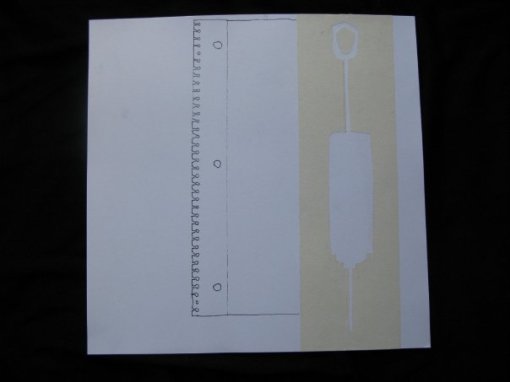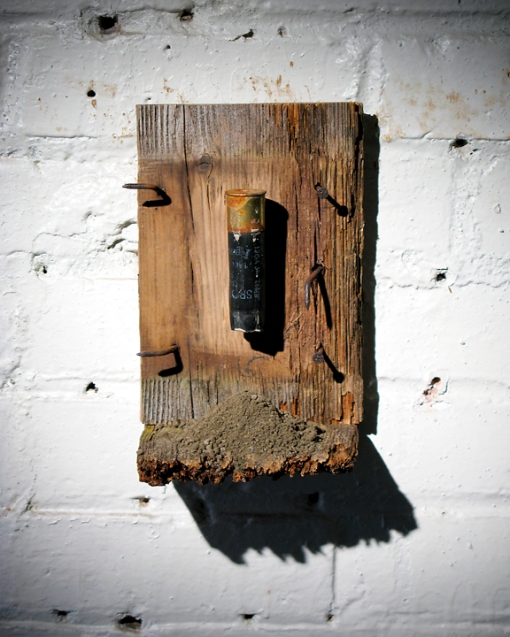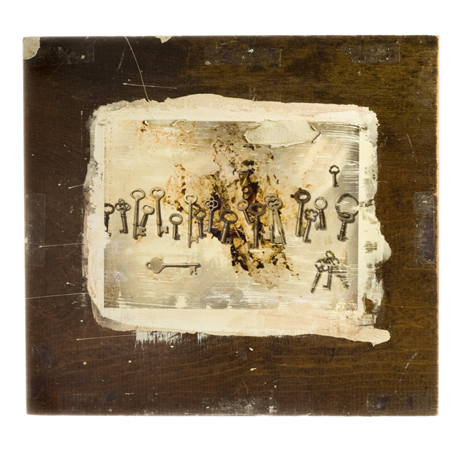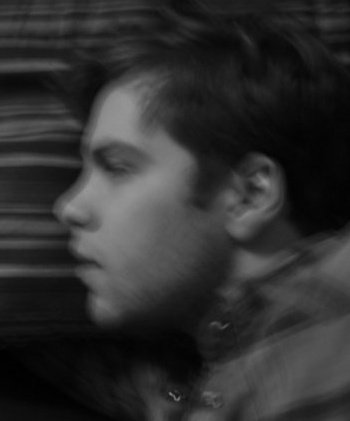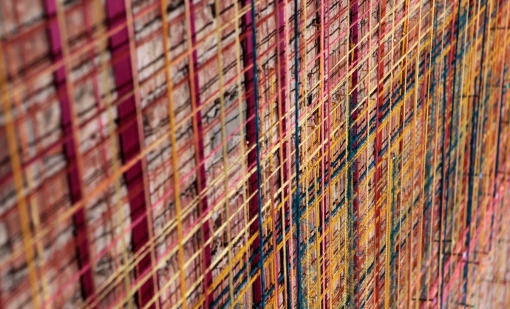
"Niagara Falls" 7x11 hand painted backdrop
Borough Gallery and Studio: You often use images of “TV Women” from the mid-twentieth century. What do you think “TV Women” today are like? Are they prodding the same desires/anxieties as in the 60s, or do they present whole new problems for women and their identity?
Jude Bond: I grew up in the early days of television. My sister and I watched many shows about the supposed happy family life. There was Leave it To Beaver, Father Knows Best, The Donna Reid Show, and many more. The women in all these shows were moms and they were all “stay-at-home moms”. There was very little discussion about a career other than being a homemaker.
These women were running the household and not a corporation but were bright savvy women. They did all the cooking and the cleaning yet still had a certain glamorous appearance. Their houses were shiny, and so were they. These were “domestic goddesses”.
The women I recall as “Sirens” or “Sex Kittens” were single and appeared more often in film than in television. They were women like Marilyn Monroe and Ann Margaret. They were not usually wives and mothers. They were the girlfriends, or the object of some man’s desires.
In fact the most significant media role model I had as a girl was in literature not television or film; the incomparable Nancy Drew. This series for young girls had a powerful influence on me. Nancy gave me courage and hope through all of her adventures and escapades. She was afraid of nothing, and she was also smart and kind. She used her intellect and her sleuthing skills to help people, which appealed to me. When I was reading these books in the early 60’s there were few female heroines in literature for girls to emulate, and I was utterly and completely hooked.
A few years back I did a series about Nancy Drew. I re-read a couple of the books while working on the series and they are cheesy and dated, and yet so, so good. In the Secret of The Old Clock Nancy gets locked in a closet and manages to escape by using the closet pole as a lever to jimmy the door off its hinges, saves a child from drowning, rescues an old woman who had a bad fall, changes a flat tire, fixes a broken motorboat engine, and of course, also solves the secret in the old clock and brings a much deserved fortune to family and friends of a recently deceased gentlemen whose last will and testament could not be found. Whew! Wow! And all this while also dressing smartly and being warm and friendly to all she comes in contact with.
But back to television and your question…
What is most interesting to me about television shows from this time period is something no-one ever seems to talk about. This is the curious fact that there were several shows in which the mother had died. There was My Three Sons, Sky King, Bachelor Father, Bonanza, just to name a few. In these shows it was as if the absent mother enabled the surviving father and children, whether young or old, to take on roles they would not have been allowed to have otherwise. The men got to be the nurturers as in My Three Sons, or got to go on dates, as in Bachelor Father, or the female child got to have more adventures than perhaps an overprotective mom would have allowed, as in Sky King. This was also the case in the Nancy Drew mystery series. Nancy’s mother had passed away and her father was less protective than perhaps a tv or novel mom of that time would have been, allowing her to have a life filled with dangerous adventures.
TV women of today exemplify a much broader range of options than those of yesteryear. Today’s TV women are doctors, lawyers, cops, judges, car dealers, designers and moms and housewives. Yet, some of the same underlying stereotypes still apply and some of the same struggles exist. What I find most interesting about contemporary television is that one of the most popular shows is Mad Men, which is set in the 50’s and 60’s. Several of the key female characters intrigue us precisely because they do not fit the mold. They do not behave as we might expect from a show set in that time period. They are not kind and loving mothers, or good Catholic girls, or long suffering secretaries or wives. They are questioning their roles and daring to step outside the parameters of tradition.
BGS: Your art uses traditional domestic skills, stitching, quilting, etc… yet you say you’re not a “domestic goddess” yourself. What was it like learning these skills and applying them to art that asks the viewer to question their tradition?
JB: You are correct. I am not a Domestic Goddess. I come from a long line of Domestic Goddesses, but I did not inherit the gene. I grew up in a time when moms stayed home and cooked and cleaned and sewed and had dinner on the table each night with meat, potatoes, vegetables and a home-made dessert. My mom sewed matching dresses for my sister and me, knitted sweaters, stitched quilts, hooked rugs and embroidered pillow cases.
As a young girl I was taught to embroider, sew, and crochet. I spent many pleasant hours in solitude practicing these skills. I loved the techniques, but as I came of age I avoided them as if they would create snares that would trap me in the domestic life.
As an adult I returned to “women’s work” and the medium I love, to create works about home and domesticity, and to address issues of women’s roles in contemporary society. Using this medium to comment on the very thing that it has come to represent appeals to my sense of humor and irony. It also gives a new view to the long history of “women’s work” as fine art.

"Hand in GLove #2" textile
BGS: Snares and traps are also present in the creative process: creative blocks; anxieties and fears; addiction to research and information; getting caught in imitation of another’s work. Are there any traps your art has been caught in and now learned to avoid? Are there parts to your process where you must tiptoe to avoid being ensnared, and others where you can run without fear?
JB: This is an interesting question and very relevant to me. Over the years I have dabbled in many different mediums. What I have found is that when I do more traditional work, say painting or drawing, there is a constant voice in my head that says things such as “that is not the way it is done”, or “that is not good enough”, “you are not a painter” etc.
I am very drawn to traditional landscapes and still lifes. If you saw the art work that adorns the walls in my home you might be surprised, as it consists almost exclusively of paintings that were purchased for a few bucks each at yard sales. These paintings touch me with their earnestness and encourage me to try again someday when perhaps the voices have abated.
In contrast, when I work intuitively with a vast array of elements gathered from near and far, I never hear these discouraging voices. Quite the opposite, I get energy and encouragement from the elements I piece together; from the doilies, undies, gloves and textiles. I feel completely free to make the work the way I wish to, and in the way that my muses lead me. The only things that hold me back are technical issues, and then I just set out to learn the new skills necessary to complete the work the way I envision it. Often these technical solutions come to me in dreams and I awake in the morning with a pleasant little “aha”.
I am happy to say that I have never had a creative block since I began to make art seriously. I feel very blessed in this regard. I awake every day bubbling with ideas and am blocked only by time constraints placed on me by real world demands, such as work, socializing with other humans, and ordinary daily tasks.

"Tomatoes" textile and metal sculpture
BGS: Do you have an idilic home/lifestyle that lives in your head? Throwing away all of reality’s restraints, what would your typical idilic day consist of?
JB: My ideal scenario is as follows: I am independently wealthy. My home is in the countryside. It is a beautiful old rambling farmhouse. There are rolling fields for long walks and a brook or pond for dipping on hot summer days. My studio resides in a refurbished barn with high ceilings and lovely views. There is plenty of organized storage for my collections of art making materials. I have the time and money to go on seasonal forays to hunt and gather at rummage sales, yard sales and thrift shops for unique art making finds. I have a once a year give-away to move wonderful materials back out into the world for others to utilize and enjoy. There is a beautiful space in my studio to teach workshops and classes for adults.
Most mornings I awake early and carry my coffee to the studio to begin my day. Most days are spent here. I do not have to earn a living through my teaching or my art or craft work, but choose to volunteer in the Early Arts program I now coordinate. Once or twice a week I go into town to teach art to preschoolers in their classrooms. This keeps me in touch with the joy, spontaneity, and seriousness of art making. The children inspire me and keep my work fresh and make me feel like I am giving back to the community in some small way.
I am still a member of 215 College Gallery, so I have the support, encouragement and opportunities that provides. I also show at other galleries across the country from time to time and have the flexibility in my schedule to allow for these travels and opportunities. Life is good!
For more information on Jude Bond go here. To see more of her work visit 215 College Gallery or check to see where she’s exhibiting next .


